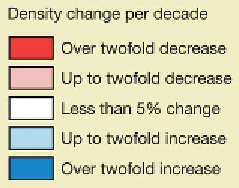Geoscience Reference
In-Depth Information
Figure 11.8
The change in the concentration of krill
between 1976 and 2003. (Atkinson, A., V. Siegel,
E. Pakhomov
. (2004). Long-term decline in krill
stock and increase in salps within the Southern Ocean.
Nature
et al
, 432,100
-
103)
krill population overwinter in the Peninsula region feeding on the algae that grow on
and in the sea ice. Also warmer winters favour smaller phytoplankton, such as
cryptophytes; these are not consumed as effectively by krill. A larger population
of cryptophytes means a smaller population of diatoms since the two species
compete for nutrients. Smaller diatom populations mean less food for krill and
hence less food for predators.
As the sea ice melts in summer the krill population advects into the South
Atlantic where a very marked reduction in krill has been observed in the last
30 years. There has been a corresponding increase in the numbers of transparent
tube-like creatures known as salps, animals which live in warmer, less food-rich
areas. The impact of these changes has been reduced populations of the top
predators around South Georgia.
There is considerable year-to-year variability in the concentration of krill in the
vicinity of South Georgia. The variability appears to be a consequence of the El




Search WWH ::

Custom Search